Carol Van Natta's Blog, page 29
November 4, 2015
Minder Rising is a Best Seller
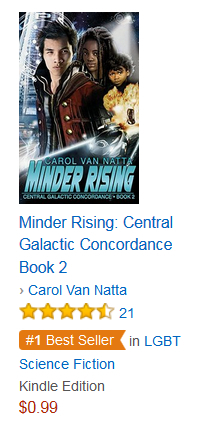 Thanks to all who purchased Minder Rising over the weekend, and helped it achieve the coveted #1 Best Seller tag from Amazon.
Thanks to all who purchased Minder Rising over the weekend, and helped it achieve the coveted #1 Best Seller tag from Amazon.
It’s the little victories that are fun for an author. Sure, big victories are fun, too, but fame is fleeting, and life is short, so enjoy it while you can. I know I am. 
October 31, 2015
Minder Rising is on sale
Just a brief post to let you know that Minder Rising (standalone book 2 in the CGC space opera romance series) is on sale worldwide for $0.99 through 2 November, so pick up your copy today. If you’ve already read the book, it makes a great Time Lord Day (a.k.a. end of Daylight Saving Time) gift. 
October 13, 2015
One Year Ago, and One Year From Now
One year ago, on Oct. 18, I published Overload Flux, the first book in my Central Galactic Concordance (CGC) science fiction series. It was a leap into the unknown seas of independent publishing, though plenty of others had gone before me and reported that the water was fine. I thought the book was pretty good, as did my brave beta reviewers, but the first positive reviews by total strangers were a relief. My journey to get there was exhilarating when the plot blossomed, frustrating when I didn’t know how to do what I wanted, and all-consuming—just ask the resident Mad Scientist, who was convinced I had become enslaved by my computer.
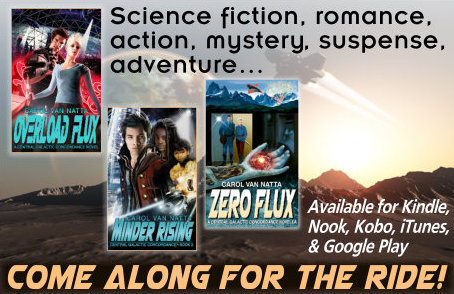 After that, I wrote and published Minder Rising, the second, standalone book in the series, and Zero Flux, a sequel novella to Overload Flux because fans kept asking. That’s another pleasant surprise: I have fans. Astonishingly, there are people who are not related to me, or even in the same state or country, who like my work enough to write and tell me so, or comment on the story, or ask when the next book is coming out. Not many, mind you; my fans are not yet legion. I know it’s common for a writer to say they write for themselves, but for me, that’s shorthand for “I write what I like to read and want to share with others.” When I hear from a reader, or when someone writes a nice review on Amazon or Goodreads, or just posts something complimentary on Facebook, it’s worth all the trouble. Overload Flux even won a SFR Galaxay Award and was a finalist for two others.
After that, I wrote and published Minder Rising, the second, standalone book in the series, and Zero Flux, a sequel novella to Overload Flux because fans kept asking. That’s another pleasant surprise: I have fans. Astonishingly, there are people who are not related to me, or even in the same state or country, who like my work enough to write and tell me so, or comment on the story, or ask when the next book is coming out. Not many, mind you; my fans are not yet legion. I know it’s common for a writer to say they write for themselves, but for me, that’s shorthand for “I write what I like to read and want to share with others.” When I hear from a reader, or when someone writes a nice review on Amazon or Goodreads, or just posts something complimentary on Facebook, it’s worth all the trouble. Overload Flux even won a SFR Galaxay Award and was a finalist for two others.
Before I published any of them, I decided on the indie publishing route, partly because traditional publishers won’t touch science fiction romance, and partly because the larger publishers treat authors badly because, well, it’s tradition. I’ve met numerous authors who are happy with their publishers, and I know some small to mid-sized publishers offer good value for the high percentage they take in royalties. For me, I’d rather be in control of my own destiny, and pay for the failures or reap the rewards for the successes. I can release books on my own schedule, as fast as I can write, not based on the publisher’s desire for only one or two long books a year because it fits their business model for a given genre. I can lay low, marketing-wise, until I have enough books out to satisfy demand and build a following over time, not sink to the bottom of the pond and sleep with the fishes because my series isn’t the next Hunger Games/Twilight/etc. I can also react to a changing marketplace and take advantage of new opportunities a lot faster—no need to argue with the corporate marketing department about buying an ad in SFR Quarterly when they review my book or whether buying a promo on a new SF-focused email list is a good investment. And I can learn from the successful indies who are generous with their expertise and honest about their experiences, such as Lindsay Buroker, J. A. Konrath, Kristine Kathryn Rusch, and others.
One Year From Now
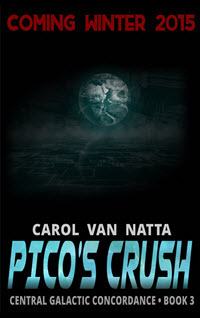 So what’s next? First out of the gate will be Pico’s Crush, book 3 in the CGC series. It’s a standalone story with new adventures and characters, plus some returning characters from previous books. My best crystal-ball prognostication says the book will be out in January. After that, I have high-level plot sketches for the next two or three books in the series. I’m learning how to be a better writer with each book, which is as it should be, and my goal is to get good enough to do full justice to the Big Damn Story Arc® in my head. When book 4 comes out in late spring and book 5 in late fall (fingers crossed and appropriate sacrifices made to the author gods), I’ll probably do print versions of all my novels. They cost a little more and take a little longer to make back their return on investment, but I’ll have something tangible to offer to potential readers beyond business cards and postcards of the ebook covers, lovely though they are.
So what’s next? First out of the gate will be Pico’s Crush, book 3 in the CGC series. It’s a standalone story with new adventures and characters, plus some returning characters from previous books. My best crystal-ball prognostication says the book will be out in January. After that, I have high-level plot sketches for the next two or three books in the series. I’m learning how to be a better writer with each book, which is as it should be, and my goal is to get good enough to do full justice to the Big Damn Story Arc® in my head. When book 4 comes out in late spring and book 5 in late fall (fingers crossed and appropriate sacrifices made to the author gods), I’ll probably do print versions of all my novels. They cost a little more and take a little longer to make back their return on investment, but I’ll have something tangible to offer to potential readers beyond business cards and postcards of the ebook covers, lovely though they are.
In 2016, I plan to attend the Northern Colorado Writers Conference in Fort Collins, CO, because it’s in my home town, and I always learn something I need to know at the time. I’m likely to attend the *humongous* RT Booklovers Convention, which will be in Las Vegas, and probably the RomCon Readers/Writers convention in Denver, to connect with other genre authors and fans.
 In my dreams, I’d like to publish audio versions of my books, but because my books use words and phrases from a dozen languages, from Mandarin to Icelandic to Polish, I’ll have to work closely with the producer and voice talent to get them right, and there are only so many hours in the day for activities that aren’t writing the next book.
In my dreams, I’d like to publish audio versions of my books, but because my books use words and phrases from a dozen languages, from Mandarin to Icelandic to Polish, I’ll have to work closely with the producer and voice talent to get them right, and there are only so many hours in the day for activities that aren’t writing the next book.
After that? Who knows, maybe I’ll start another series, maybe science fiction, fantasy, or steampunk. (Ideas: I gots ’em.) Or maybe I’ll write books 6 through 9 in the CGC series, because yes, the Big Damn Story Arc demands them. One thing’s for sure: I’ll be off the streets and out of the karaoke bars for the next few years.
★·.·´¯`·.·★ ·.·´¯`·.·★ ·.·´¯`·.·★
If you’re a reader who likes my books, thank you for buying, enjoying, and recommending them to your friends. If you’ve posted reviews of my books on Amazon and/or Goodreads, you get special thanks, because your time and effort help other potential readers find my books, too. Please reward yourself with a kitten video from Simon’s Cat.
The post One Year Ago, and One Year From Now appeared first on Carol Van Natta - Author.
September 22, 2015
New Release: Zero Flux
 New Release: Zero Flux (A Central Galactic Concordance Novella)
New Release: Zero Flux (A Central Galactic Concordance Novella)A very cold case, a secret lab, and the find of a lifetime. Which one is worth killing for?
Buy your copy of Zero Flux today and continue the adventure.
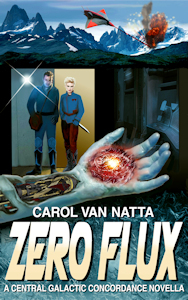
New Release: Zero Flux
Luka and Mairwen (Overload Flux) take on a very cold case, a secret lab, and the find of a lifetime. Which one of them is worth killing for? Forensic investigator Luka Foxe had gladly left his troubled past far behind, so only a plea from his old friend and mentor to investigate a violent crime scene frozen in an ice cave could have lured him back. Unfortunately, his old friend knows far more than he’s telling, which could get them all killed, even with security specialist Mairwen Morganthur on their side. An unexpected ice fall reveals a hidden lab buried deep in a mountain and the find of a lifetime. Now someone is trying to make sure those secrets stay frozen in time, even if it means more deaths…
Amazon Kindle | Nook | Kobo | Google Play | iBookstore coming soon | All Romance Ebooks | Amazon.co.UK
Zero Flux is a sequel novella and is best enjoyed after reading Overload Flux, the novel that introduces Luka, Mairwen, and the worlds of the Central Galactic Concordance.

Publisher: Chavanch Press, LLC
Publication Date: 21 September 2015
ASIN: B015NMZBJ4
Cover Art: Ann Harbour
Copy Editor: Shelley Holloway (Holloway House)
Length: Novella (17,000 words)
Series: Central Galactic Concordance 2.5
Note from the Author
Luka Foxe and Mairwen Morganthur, the lead characters from Overload Flux, came to me on a snowy spring day and told me they had a little mystery to solve. If you know Mairwen, she can be quite, uh, persuasive, so I wrote their story.
The Central Galactic Concordance series is now:
Overload Flux (Central Galactic Concordance 1)
Minder Rising (Central Galactic Concordance 2)
Zero Flux (Central Galactic Concordance 2.5)
Pico’s Crush (Central Galactic Concordance 3) — coming this winter
The number sequence is timeline-based. The upcoming Pico’s Crush will have new characters plus appearances from people in Overload Flux and Minder Rising.
The post New Release: Zero Flux appeared first on Carol Van Natta - Author.
September 19, 2015
Flash Sale: OVERLOAD FLUX is only $0.99 this weekend only
NEWS: Overload Flux is on sale for only $0.99 through 21 Sept. 2015. COMING SOON: A new novella in the Central Galactic Concordance series. Zero Flux continues the adventures of Luka and Mairwen from Overload Flux. If you already have a copy of Overload Flux, you could tell your friends today about the great deal and be their hero.
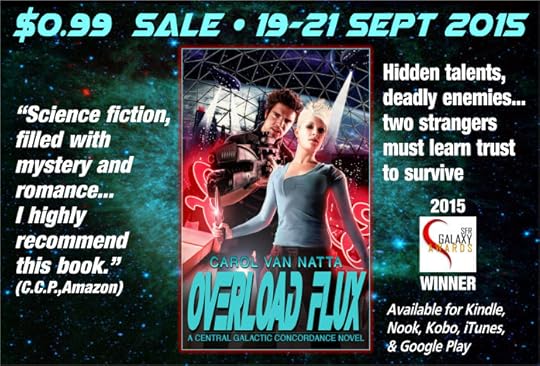
If you subscribe to discount newsletters such as Free Kindle Books and Tips, the Midlist, E-Reader News Today, and others, you’ll see the flash sale for Overload Flux listed.
Coming Soon: Zero Flux
 Zero Flux
Zero Flux
A Central Galactic Concordance Novella
by Carol Van Natta
Luka and Mairwen (Overload Flux) on a very cold case, a secret lab, and the find of a lifetime—any one of them would be worth killing for…
A very cold case of murder turns out to be the tip of the iceberg when forensic investigator Luka Foxe and security specialist Mairwen Morganthur investigate a crime scene on the frigid home world that Luka left long ago. An unexpected ice fall reveals a hidden lab buried deep in a mountain and the find of a lifetime. Now someone is trying to make sure all those secrets stay frozen in time, even if it means more deaths.
Luka gladly left his troubled past behind long ago, so only a plea from his old friend and mentor to investigate a violent crime scene frozen in an ice cave could lure him back. Unfortunately, his old friend knows far more than he’s telling, which could get them all killed, even with Mairwen on their side.
– – – – – – – – – –
Scheduled release date: 23 Sept. 2015
The post Flash Sale: OVERLOAD FLUX is only $0.99 this weekend only appeared first on Carol Van Natta - Author.
September 14, 2015
Pet Peeves: Dubious Consent in Romance
This is one of an occasional series on my pet peeves about romance. If you’re not in the mood for a long rant, please go look the hilarious cat videos on YouTube.
Dubious Consent in Romance Has Got to Go
I love to read, and I read a lot. I almost always finish the book, even if, despite the great cover and promising blurb, I find I don’t care for it. It’s usually a brief element that I can skip past, such as an unexpected BDSM sex scene, or gratuitous violence, or an extended/repetitive description that doesn’t further the plot. However, several of them in the first chapter, along with a heavy dose of dubious consent, grinds me to a screeching halt. I’ll angrily stab the “remove from device” link, growling the whole time. Not as satisfying as throwing the book across the room (making it a “wallbanger”), but e-readers are expensive. It is just that sort of book that prompted this post.
 Paranormal Romance is a Haven for Dubious Consent
Paranormal Romance is a Haven for Dubious ConsentIn addition to reading science fiction romance, I read a fair number of paranormal romances (PNRs) with shape-shifters, vampires, gargoyles, demons, etc., and they share an all-too common flaw: dubious consent. The magic creature (werewolf, vampire, etc.), usually male, meets someone, who turns out to be his fated mate (or true mate, or The One, etc.), and feels entitled to do whatever it takes to get his love interest to accept fate and love him forever.
Sidebar: For those of you who don’t read the genre, the “fated mate” is usually a magical or biological response to a person who they can love and have that love returned. The significance of this runs the gamut, from there being only one, special person for which the magic creature has waited decades, centuries, or even millennia to meet, to just a handy indicator that the new person is biologically compatible enough to produce offspring, not poison one another, etc. Similarly, mating can mean an intertwining of souls and binding together until death, or it can just mean wicked good sex.
So where does the dubious consent part come in? In far too many cases, the male magic creature knows what’s happening — his hormones are taking him for an E-ticket ride and his family lore tells him why — but the object of his sudden, overwhelming obsession doesn’t. The poor love interest, who is usually human (or thinks so) and is often equally overwhelmed by desire, because magic and shut up, can’t imagine why the smokin’-hot, sexy man has cornered them, and why their own body is inexplicably singing the Hallelujah Chorus. We’re supposed to envy the love interest, because who wouldn’t want some hot man pursuing them, and commiserate with the hero, who wasn’t expecting his fated mate to drop in his lap. Does the hero tell his love interest what’s going on? No, he does not, because that’s how the lazy author creates cheap tension (“I kissed a what?”) and cheap relationship building all in one package. It’s the rapey hero, gone underground.
Prime Example of Dubious Consent
So, in the book that set me off (no, I’m not going to tell you the title or author, because this is about dubious consent in general, not just this egregious example of it), we have:
Hero with magic mental gifts, who is lonely because he’s so powerful, and horny, because he can’t have wild kinky sex with lesser talents, visits the rural countryside looking to get laid, because he doesn’t have to exercise any control while boinking the untalented.
Virginal heroine with magic mental gifts, which she’s hiding because she doesn’t want to be abused, exploited, or killed, who lives quietly in the rural countryside
Hero is introduced to heroine, senses her magic gifts and knows that she’s hiding something; he sexually harasses the unwilling and frightened heroine, but is foiled by crowds.
 Hero uses local hospitality rules to corner her at night in a barn, tells her {sarcasm alert} she’s safe and he’d never hurt her, then does the following:
Hero uses local hospitality rules to corner her at night in a barn, tells her {sarcasm alert} she’s safe and he’d never hurt her, then does the following:Makes her thank him for doing her the honor of seeking her out;
Causes her blinding, debilitating pain to force her to reveal her magic mental gift;
Rifles through her thoughts while she distracted by the pain to discover her tragic childhood, the secret of her power, and that she has no one to protect her;
Uses his mental gift to rev up her hormones, so she’ll quit trying to escape;
Takes her virginity roughly, telling her “sorry about the blood and pain, you know you wanted it, and it had to happen sometime” (I’m not making this up);
Thinks her skin is so smooth that he’ll only spank and whip her “when she deserves it,”
Wraps her friggin’ nipples with tight metal chains right before her second orgasm so “everyone will know she belongs to him” (not making this up either);
Uses his mental gifts to clean up the body fluids from her abused girly parts, then laughs when it startles and frightens her (this gives him an erection);
Announces that she’s coming with him to be his “student,” so she should pack her things, because she needs training, and better him than the bad guys she was hiding from all those years. She, in pain, bewildered, and overwhelmed, agrees…
BANG!! That was the virtual sound of the ebook hitting the wall.
The point of view was mostly evenly split, and the male’s thoughts were all “oh, lucky me, a strong talent at last, who will happily take everything I can dish out once I tell her who I am and what I want, I’ll train and discipline her for her own good,” and the female’s thoughts were mostly “must hide, but he’s so handsome, oh god the pain, I’m scared of men, I’ve never felt like this before, it must be love.” Now maybe I should have read more, to find out if she ever gained any sense at all, but by then, I was so riled that the story could only have been redeemed if the heroine, after realizing the hero had lied to her, drugged her, date-raped her, permanently scarred her, and kidnapped her, spent the next few chapters bashing his head in, tying his naked and artfully bloodied body to the hood of his space shuttle, and going on a long joy ride through the upper atmosphere.
Oh, did I forget to mention this wallbanger book was billed as “science fiction romance”? That’s probably another reason why it pushed my rant buttons. I’ve regretfully come to expect that kind of dubious consent stuff from PNR authors, but not so much from SFR (not counting the erotica dressed up in SF spacesuits). My favorite, feisty little SFR genre isn’t entirely blameless, because there are far too many alien males (albeit hunky, well-meaning, and well-endowed) who, having to few females of their own species owing to some calamity, take to kidnapping random (but spunky!) human females for breeding purposes. Oh, and SFR has way too many slave auctions. I’ll also admit some PNR authors do consider the implications of fated mates, such as, what if you don’t like your fated mate, even while your body is having a blue-light special on sex hormones? What if your fated mate, knowing nothing of his/her status as the one person “meant for you,” is already happily married to a normal human and has kids? What if he or she is eleven years old, or eighty-nine?
Other examples of dubious consent:
In PNR, it’s okay if the main character, knowing the love interest is completely ignorant of the magic-creature social practices (because they’ve been hiding from humans for millennia), permanently marks the love interest because he or she agreed to it in the hormone-drugged height of passion. Didn’t agree to get married? You shouldn’t have accepted and worn the carved wooden spoon, then.
In PNR, it’s okay if the main character is in heat (it happens to female shape-shifters a lot) and uses her powerful pheromones to influence any random male she wants, and because everyone knows that no man turns down free sex. This is the magical equivalent of giving him rohypnol and justifying it by asserting he’d have participated willingly anyway, sooner or later.
In PNR, it’s okay if the main character forces the love interest into a slave/employee/dependent role, then declares eternal love and “asks” if the love interest wants to be claimed. This only works if the love interest can say “no” with no consequences — no punishment, no lost job, no being cast adrift. If the love interest believes they have no choice, that’s not consent, that’s coercion or blackmail, just like the melodramatic villain of old who secretly steals the rent money from the ingenue, then demands sex when she can’t pay.
Special Plea to PNR and SFR Authors
Dear Authors:
You’d think that here in the modern world of the 21st Century, we’d understand the notion of informed consent, and that it’s a prerequisite for non-forced or non-coerced sex. Sadly, no. A slave is not the owner’s “mistress“; that word implies equal standing and a mutual agreement for behavior. Being drunk at a bar is not the same as saying “yes, please gang-bang me.” Wearing a skirt is not saying you want someone groping your privates.
Does dubious consent happen in real life? Unfortunately, yes. Here’s the thing: It’s wrong. Evil. Bad. Anti-social. People deservedly get punished and go to jail for it. But in a paranormal romance (or the SFR wallbanger example), it’s treated as excusable, forgivable, normal, or even laudable behavior.
Stop. Just stop.
Make a pledge starting today that the next time you have your main character blitz-attack the love interest because of fate, you’ll erase that section and start over, because no one deserves that fate, least of all your readers. Give us readers a reason to want the main character redeemed for his/her arrogance, or your book will be our next wallbanger. I don’t write reviews, because as an author, too, I can’t be objective about someone else’s work, but other readers won’t be so circumspect. If your main characters stumble, make mistakes, or realize they must change or they’ll lose everything, that’s what makes a story. If your main characters respect each other enough to tell the truth, treat each other fairly, and to look out for for each other, then we’ll not only love your book, we’ll recommend it to our friends.
I believe the romances are subversive, and have the power to change the world, one book at a time. Let’s agree to change the world for men and women everywhere: You write the books in which there is no dubious consent, or it’s a very bad thing, and we readers will snap them up. Deal?
Your friend and hopefully loyal reader,
Carol
.
The post Pet Peeves: Dubious Consent in Romance appeared first on Carol Van Natta - Author.
September 2, 2015
The Settings for My Books
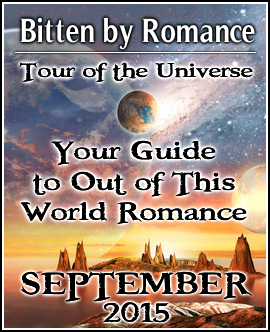 The Tour of the Universe (sponsored by Bitten By Romance) is featuring the City of Spires, the setting for Minder Rising.
The Tour of the Universe (sponsored by Bitten By Romance) is featuring the City of Spires, the setting for Minder Rising.
I initially set Minder Rising in the capital, showcase city of the Central Galactic Concordance, because I wanted to explore the official view of minders, to explain Agent Lièrén Sòng’s background and general assumptions about how things worked. Imara Sesay is almost the opposite — she sees the sides of the city and people that few others do, both in her capacity as a road crew chief and a bartender.
Location, Location, Location
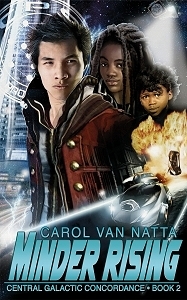 I tend to think of settings as almost another character, because the ambiance and sensibility can have profound effect on the human characters. Big cities have multiple personalities—the business district, the gated community, the entertainment block—for variety, but even small towns have it, such as the cliché “wrong side of the tracks.” The City of Spires is made of glass, a planned urban artwork as architecture, but underneath its showy facade, it’s cold and inflexible, and requires constant upkeep. That’s the backdrop for Minder Rising, and Agent Sòng’s struggle to find the truth, and for Imara to protect her son.
I tend to think of settings as almost another character, because the ambiance and sensibility can have profound effect on the human characters. Big cities have multiple personalities—the business district, the gated community, the entertainment block—for variety, but even small towns have it, such as the cliché “wrong side of the tracks.” The City of Spires is made of glass, a planned urban artwork as architecture, but underneath its showy facade, it’s cold and inflexible, and requires constant upkeep. That’s the backdrop for Minder Rising, and Agent Sòng’s struggle to find the truth, and for Imara to protect her son.
In Overload Flux, Luka Foxe and Mairwen Morganthur both work for a security company, La Plata, and I needed a reason why the company headquarters would be there. I came up with the city of Etonver a thriving, sprawling mess that allows open-carrying any kind of weapon imaginable. This, I figured, would naturally attract companies that used weapons in their day-to-day business, such as mercenaries, security companies, etc. It’s a kind of libertarian sensibility, so I added another side of lax regulations in the free-for-all zoning and notoriously bad traffic. By the way, Overload Flux will be on sale Sept. 19-21 for only $0.99—if you already have it, tell your friends about the great deal.
In the upcoming Zero Flux, a short novella, the setting is the coldest settled planet in the Concordance. Luka and Mairwen are investigating a very cold case, so what better location than an ice cave in winter?
One of the joys of being a science fiction writer is the fun of thinking up new locations and new ways people live and interact with their environment.
The post The Settings for My Books appeared first on Carol Van Natta - Author.
August 9, 2015
How Indie Authors Get Paid
 A friend of mine who is an avid reader (and luckily, a fan of my books) asked how authors get paid when their books sell.
A friend of mine who is an avid reader (and luckily, a fan of my books) asked how authors get paid when their books sell.
For now, I’ll stick with what I know, which is how indie authors get paid for genre fiction. Caveat #1: I’ve only been at this for ten months, so some of my knowledge is hearsay from what other authors have said, or theoretical, because only in my dreams do I know any best-selling authors well enough to ask them money questions. Caveat #2: I publish from the U.S. If you’re in another country, your mileage may vary.
Expenses for Indie Books

Let’s start with what it costs to get a manuscript (a.k.a. “Magnum Opus”) published thither and yon.
First, Magnum Opus needs an editor. Yes, Magnum is a glorious masterpiece, but still needs a bit of tailoring to clean up the dangling threads and loose buttons. Depending on your confidence, skills, and whether or not you have detail-oriented beta readers, you may want a developmental or content editor, or may just need a copy editor. Costs range from a $400-$4,000, and in general, you get what you pay for (unless you’ve been sucked into a dubious services like those described at the very helpful Writer Beware). My editor is Shelley Holloway of Holloway House, and I highly recommend her. If you make enough changes after the editor is done, you might want to pay for a quick proofread, too, so your book doesn’t get snarky reviews about typos and bad grammar.
Next, Magnum Opus needs a professional cover. I don’t recommend going cheap on this, either, or your book ends up on Lousy Book Covers, Bad SF Covers, or Kindle Cover Disasters. A tolerable premade cover can be found for around $70-$80, but of course, it isn’t designed specifically for Precious. Good custom covers start about $120 and go up from there.
PRO TIP: Cover design is NOT just slapping artwork and words on a page; it’s a very specialized visual that has to draw the eye, communicate the genre, and be intriguing enough to make a reader read the book’s blurb. Good cover designers know their stuff; unless you’re an artist yourself, you should listen to them.
 I love illustrated covers (as I discussed in a previous post), and my excellent cover artist is Stephen Bryant at SRB Productions. This is the point where you’ll need to decide if you’re going with only electronic editions, or paper as well, because it costs $25-$300 more to get the print cover, but less if you do it now, than if you later ask your artist to create a print version from your ebook cover design. Good cover design helps Magnum Opus compare favorably to books from traditional publishing.
I love illustrated covers (as I discussed in a previous post), and my excellent cover artist is Stephen Bryant at SRB Productions. This is the point where you’ll need to decide if you’re going with only electronic editions, or paper as well, because it costs $25-$300 more to get the print cover, but less if you do it now, than if you later ask your artist to create a print version from your ebook cover design. Good cover design helps Magnum Opus compare favorably to books from traditional publishing.
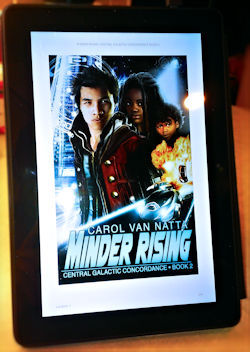 Lastly, you need book files the publishers can use. For the e-reader edition, you’ll need EPUB and MOBI files (and a PDF wouldn’t hurt). You can buy software to do it yourself or pay a conversion service. I do the latter, and use the very experienced and fast Ted Risk at Dellaster Design. He makes them look real purdy and work well with all the major e-readers and tablets.
Lastly, you need book files the publishers can use. For the e-reader edition, you’ll need EPUB and MOBI files (and a PDF wouldn’t hurt). You can buy software to do it yourself or pay a conversion service. I do the latter, and use the very experienced and fast Ted Risk at Dellaster Design. He makes them look real purdy and work well with all the major e-readers and tablets.
For the paper edition, the two most popular venues are CreateSpace (owned by Amazon.com) and Ingram Spark (owned by Ingram Publishing). If you aren’t anal-retentive about how it looks, it’s feasible to use one of CreateSpace’s Word templates to create the book interior. IngramSpark expects a specifically-formatted PDF file. If you really want Precious Baby to look good, hire a professional, which will cost $200-$400. A lot of indie authors are pretty good with Word, so they’ll often do this step themselves to save a little money. I only have one book in paper, and that was done six years ago, so I have no current experience. BTW, it costs money (currently $49) to produce print versions with Ingram, but they can help your book sell internationally, as CreateSpace is limited to North America.
So, outside of your time—the hours you spent plotting, researching, and writing Precious Baby—your ballpark expenses so far are:
$1,500 editing
$150 cover design
$100 file conversion (e-book)
——————
$1,750 ebook only (add another $300 for the print version)
Some authors balk at this point, because who has that kind of money lying around? It’s an investment in a business. If you can’t afford it, a viable option is to start looking for a publisher to work with. You get the benefit of their expertise, plus editors and cover designers they know and love, and you get marketing help. Of course the downside is, they’ll take a pretty big chunk of the books purchase price for their services, and you’re investing in their business, not yours. You would be correct in surmising that I’m a bit biased toward the indie publishing side of things.
Revenue for Indie Books
With files in virtual hand, you have choices as to where to upload them. You’ll also need to think about price. My advice, especially if it’s your first book: Don’t be tempted to undervalue Magnum Opus.
 Amazon is the Big Kahuna in the ebook world—even authors with plenty of books and vast readership make the majority of their ebook sales on Amazon. Amazon offers special incentives for signing with them exclusively for 90 days at a time. The retail price of your book tells you what percentage you get. For example, for a book priced between $2.99 and $9.99, the royalty payment to the author is 70%. So, for a $3.99 retail price, the author gets $2.79 per copy sold. (Compare that to a traditional publisher contract, where you might get 15%, or $0.60.) If the retail price is outside that $2.99—$9.99 range, Amazon will only pay 35% in royalties. BTW, if your book is epic-long or a huge file because of multiple illustrations, you may be charged an extra fee for sales, because Amazon has to pay extra to deliver it to the reader.
Amazon is the Big Kahuna in the ebook world—even authors with plenty of books and vast readership make the majority of their ebook sales on Amazon. Amazon offers special incentives for signing with them exclusively for 90 days at a time. The retail price of your book tells you what percentage you get. For example, for a book priced between $2.99 and $9.99, the royalty payment to the author is 70%. So, for a $3.99 retail price, the author gets $2.79 per copy sold. (Compare that to a traditional publisher contract, where you might get 15%, or $0.60.) If the retail price is outside that $2.99—$9.99 range, Amazon will only pay 35% in royalties. BTW, if your book is epic-long or a huge file because of multiple illustrations, you may be charged an extra fee for sales, because Amazon has to pay extra to deliver it to the reader.
You may have heard of the Kindle Unlimited (KU) program, wherein you as a reader pay a flat $10 monthly fee to borrow any book in the program. That last part is key. To be in the program, authors must sign up and agreement to sell exclusively through Amazon (not Nook, iBooks, Kobo, Google Play, etc.) for 90-day periods. Amazon pools the borrow program money and adds an unspecified additional amount into a pool, then pays authors based on the number of pages read of the book. The net profit per book is usually less than the 70% from regular sales, but being in the KU program means more books read and sold because Amazon markets them more aggressively. It’s generally a better sales tool for authors who have three or more books out, especially if they’re in a series.
Paper book sales for fiction can bring in a modest income, and for some authors, a lot, but for those of us with few books out and a small fan base, it doesn’t make economic sense. If I’m lucky, I make $2.50/copy, meaning I have to sell around 120 of them just to break even. To do that, I need to hand sell (e.g., set up a table at a science fiction convention, convince readers they make great gift) or get them in bookstores, which is its own can of worms.
Amazon, Kobo, Nook, iTunes, and Google all pay authors every 30 days for the sales they made two months before (e.g., the payments I got at the end of July were for sales in May). For comparison, most traditional publishers only pay every 6 months (or annually, if the book isn’t selling well).
So, how many copies of a book sell per month? Depending on the month, zero to tens of thousands. I know, not helpful, but true. It depends on sales and marketing, timing, events, acts of nature, luck, competition, and a dozen other factors that none of us understand. And by none of us, even big traditional publishers, because the ground is shifting beneath their feet as much as it is for indie authors. But we all do get paid, eventually, because you, dear reader, buy and and read what we have on offer. For which, I thank you.

The post How Indie Authors Get Paid appeared first on Carol Van Natta - Author.
July 29, 2015
5-stars for Overload Flux
 You’d think I’d be a bit blasé about getting another nice review of Overload Flux, the first novel of my science fiction romance series. It was published in October 2014, and has 60+ reviews, most of them positive, and I’ve since written a second book Minder Rising, that I’m proud of, and am working on a novella and the the next book in the series. I’m not remotely blasé. Maybe after I write a dozen more books, but even then, Overload Flux is my first solo book.
You’d think I’d be a bit blasé about getting another nice review of Overload Flux, the first novel of my science fiction romance series. It was published in October 2014, and has 60+ reviews, most of them positive, and I’ve since written a second book Minder Rising, that I’m proud of, and am working on a novella and the the next book in the series. I’m not remotely blasé. Maybe after I write a dozen more books, but even then, Overload Flux is my first solo book.
The lovely and talented Eleanore Trupkiewicz at her Engraved: All Things Writing blog wrote a splendidly thoughtful review, wherein she liked my book and gave it 5 stars, in part because “it’s been a very, very long time since I’ve read such a compelling, unexpected, suspenseful, and well-crafted work of science fiction as Overload Flux.” The themes of the story that resonated with her are the same ones that I hoped would come through, because they resonated for me, too. You can read her full review here.
Make an Author’s Week: Write a Review
 Authors like reviews. Of course, we really like positive reviews, but we honestly like them all except the obvious trolls. (I don’t have any of those yet, but it’s inevitable.) Even the “not my cup of tea” reviews mean someone felt strongly enough about the book to post a comment. They read it, and if the author is lucky, they noticed something that escaped the author—an unconscious theme, a continuity error, a pacing problem. I want to make each book the best it can be, the best I can make it, and part of that is learning for readers what worked and what didn’t. So if you’ve reviewed one of my books, or anyone else’s, for that matter, thank you.
Authors like reviews. Of course, we really like positive reviews, but we honestly like them all except the obvious trolls. (I don’t have any of those yet, but it’s inevitable.) Even the “not my cup of tea” reviews mean someone felt strongly enough about the book to post a comment. They read it, and if the author is lucky, they noticed something that escaped the author—an unconscious theme, a continuity error, a pacing problem. I want to make each book the best it can be, the best I can make it, and part of that is learning for readers what worked and what didn’t. So if you’ve reviewed one of my books, or anyone else’s, for that matter, thank you.
The post 5-stars for Overload Flux appeared first on Carol Van Natta - Author.
July 5, 2015
Romances Are Subversive
 Romance authors, even really prolific, best-selling authors, don’t get noticed for major awards, or mentioned in articles about the publishing industry. I’ve seen more than one listing of “most important books” that goes out of its way to snub romance. But, while romances are being dismissed as unimportant, their readers are being exposed to some fairly radical ideas, like equality, independence, community, protecting the environment, justice for the downtrodden, hope for the invisible, and happiness in accepting and loving the differences in skin color, culture, or experience.
Romance authors, even really prolific, best-selling authors, don’t get noticed for major awards, or mentioned in articles about the publishing industry. I’ve seen more than one listing of “most important books” that goes out of its way to snub romance. But, while romances are being dismissed as unimportant, their readers are being exposed to some fairly radical ideas, like equality, independence, community, protecting the environment, justice for the downtrodden, hope for the invisible, and happiness in accepting and loving the differences in skin color, culture, or experience.Mix in other genres I like, and I’m with you all the way (except a few tropes that I’ve complained about here and there).
 Romances are subversive
Romances are subversive Romance is hope, happy endings, and justice. These are subversive notions to begin with, but when you include the notion that every single human being on the planet has a chance to get them, that’s tantamount to an underground rebellion. While often disrespected or dismissed, romances are subversive, and have both reflected and fueled a quiet revolution in equality and acceptance.
Romance is looked down on by most of the other genres, the way the elite “literary fiction” arbiters once looked down on any genre as appealing to the lowest common denominator in the masses. But in the private space between the written page and the reader’s mind, a quiet revolution is taking place. Whether it’s agency for female main characters, or shattering gender roles (woman doctor, soldier, engineer, assassin; male nurse, secretary, preschool teacher), or embrace of non-hetero sexuality (hence the popularity of M/M romance), hearts and minds are being changed. These non-traditional characters are taking readers on their journey to love, and it humanizes the different, the other, the unfamiliar.
Romance sells better than any other genre by itself. Some because it’s far ranging, from historical to contemporary to future, and into fantasy and alternate world, and all heat levels. While book reading may on the decline, based on recent alarming surveys, genre book sales are on the rise. If the average reader read one book per month, dedicated romance readers read two or three books per week, because, well, they can. They have a lot to choose from.
Welcome to the insurrection
Back to subversive. In the 1950s, when it was all but heresy not to have children, “women’s fiction” (mostly British, according to my mother’s friends) began suggesting women could at least have careers before children. Sure, they reflected their time, but it was a start. Cultural ideas wormed their way into author imaginations, and got incorporated into those “silly little romances,” where they quietly took root and thrived. Even if you didn’t live in Haight-Ashbury in the 1960s, notions of social justice and sexual freedom were creeping into romances. It became first daring, then acceptable for the heroine to have had sex with another man or two before meeting and falling for the hero.
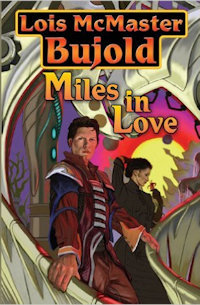 In the 1970s, sex was on the page. So-called “bodice-rippers” began selling really well, so publishers bought more, and readers had choices. It wasn’t ideal — too often, the stories involved force, from dubious consent* to outright rape, by the lead male character, who was “redeemed” in the end by the falling in love with him. Sadly, there are more recent examples. Just like Fifty Shades of Grey, the carelessly written, formulaic bodice-rippers got a lot of attention and copycats. I’ll be honest: I read a bodice-ripper in the 70s because it was loaned by a friend, and it put me off romances for a long time. It took until the early 90s for the rapist-turned-hero to finally be relegated to dark alleys.
In the 1970s, sex was on the page. So-called “bodice-rippers” began selling really well, so publishers bought more, and readers had choices. It wasn’t ideal — too often, the stories involved force, from dubious consent* to outright rape, by the lead male character, who was “redeemed” in the end by the falling in love with him. Sadly, there are more recent examples. Just like Fifty Shades of Grey, the carelessly written, formulaic bodice-rippers got a lot of attention and copycats. I’ll be honest: I read a bodice-ripper in the 70s because it was loaned by a friend, and it put me off romances for a long time. It took until the early 90s for the rapist-turned-hero to finally be relegated to dark alleys. In the meantime, authors were writing compelling, fascinating stories, maturing and widening the genre’s reach into others. Lois McMaster Bujold’s science fiction series about Miles Vorkosigan has strong romantic elements. Piers Anthony’s fantasies often had romance. The heart of James Clavell’s Shogun was a tragic romance. Paranormal romances (including time-travel romances, like the deservedly popular Outlander series by Diana Gabaldon) and urban fantasies blossomed.
___________________
* I’ll save a diatribe about dubious consent/forced seduction for another post. TL;DR version: I hates it.
The post Romances Are Subversive appeared first on Carol Van Natta - Author.









